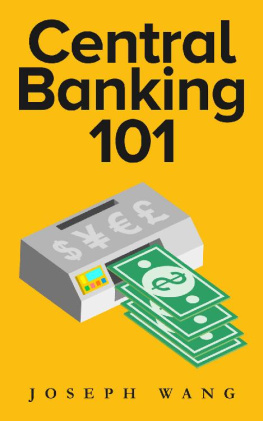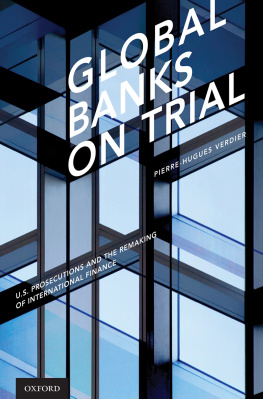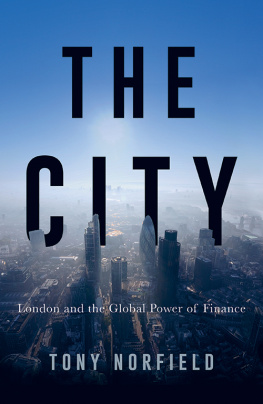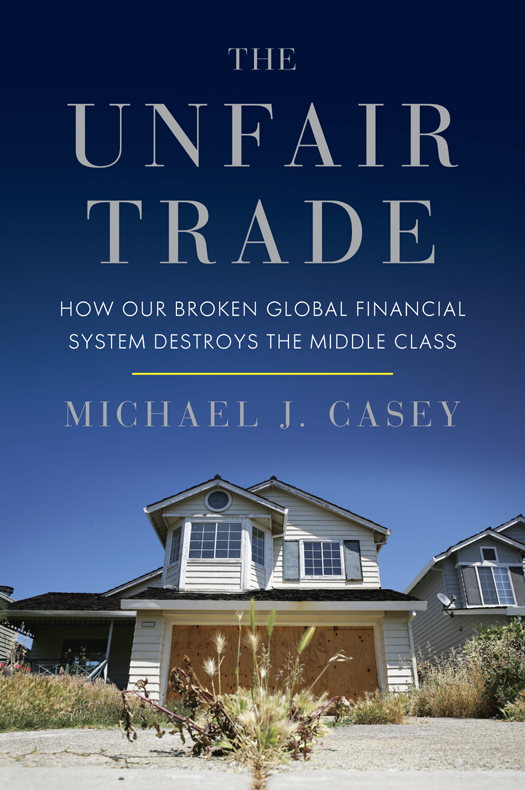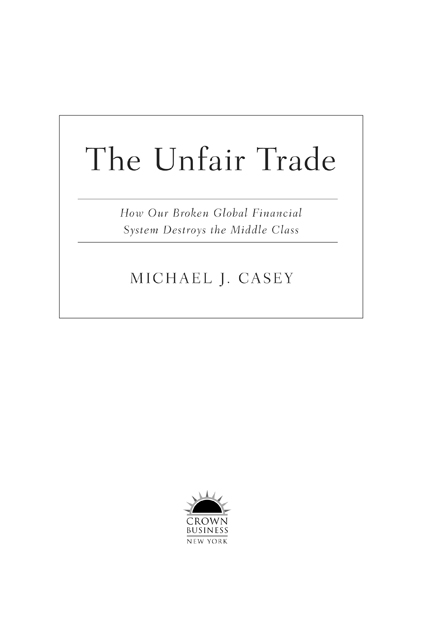ALSO BY MICHAEL J. CASEY
Ches Afterlife: The Legacy of an Image
Copyright 2012 by Michael J. Casey
All rights reserved.
Published in the United States by Crown Business,
an imprints of the Crown Publishing Group,
a division of Random House, Inc., New York.
www.crownpublishing.com
CROWN BUSINESS is a trademark and CROWN and the Rising Sun colophon are registered trademarks of Random House, Inc.
Library of Congress Cataloging-in-Publication Data
Casey, Michael, 1967
The unfair trade : how our broken global financial system destroys the middle class / Michael Casey.
p. cm.
1. FinanceHistory21st century. 2. Economic history21st century. 3. Middle class. 4. Income distribution. 5. ChinaForeign economic relations. I. Title.
HG173.C42 2012
332.042dc23 2011047163
eISBN: 978-0-307-88532-6
Jacket design by Michael Nagin
Jacket illustration by Justin Sullivan/Getty Images
v3.1
To Zoe and Analia
CONTENTS
Part One
THE RISE OF CHINA
Part Two
THE RISE OF GLOBAL FINANCE
INTRODUCTION

The View from James Street
I have a neighbor across the street in Pelham, New York, whose good humor, intelligence, and well-stocked collection of single-malt scotch make him an ideal companion with whom to mull over the worlds problems. An avid and thoughtful reader, Scott would repeatedly tell me that he hoped my book would give him reassurance. He wanted to be convinced that, after the financial turmoil and political uncertainty that have characterized Americas recent experience with globalization, eventually everything is going to be all right.
Given the spectacular recent failures of the financial system I was writing about, Scotts request for optimism was a tough ask. Still, I did respond by laying out what I saw as some of the hopeful signs of progress that globalization has delivered. There was the fact, for example, that between 1990 and 2005 the number of people living on less than $1.25 a day dropped by 400 million, putting the world on track to far surpass the UNs Millennium Development Goal of halving the rate of extreme poverty between 1990 and 2015. Or there was the seven-year increase in life expectancy from 1990 to 2010, the 47 percent decline in infant mortality over the same period, or the 11-point rise in literacy rates to 84 percent for people age fifteen and over. The relentless advance of a 1.3-billion-strong China over that time disproportionately pushed up the aggregate results, but this newfound upward mobility is truly a global phenomenon. It has spread across Asia, Latin America, and Eastern Europe. Even sub-Saharan Africa, the forgotten continent, is posting gains, with growth rates averaging 4 percent over the past four years and social indicators in health, education, and general development all showing real improvements since 2000. On an international level, Adam Smith has been largely proven right: free trade and integration led to greater and more efficient production of goods and services for all.
Yet its hard for Scott and hundreds of millions of Westerners like him to fully appreciate these advances. They associate globalization with disruptions to their lives and greater instabilityand for good reason. In 2008, the world was thrust into a nauseating financial crisis, the likes of which had not been seen in eighty years. And just three years later, with a new crisis rocking Europe, it was facing another bout of financial turmoil, this one potentially even more destructive than the previous one. These crises have shown that many of the jobs created before them were transitory, especially in the bubble-economics sectors of financial services, real estate, and residential construction. In the United States, where inflation-adjusted data show household income dropping 7.1 percent from 1999 to 2010 and the median wage of male workers unchanged from 1968, inequality widened to levels not seen since 1928, the year that preceded the Great Depression. The top 1 percent of earners received 21 percent of the nations total income in 2008, up from 9 percent in 1976, after having accounted for a whopping four-fifths of all income gains between 1980 and 2005. Globalization and the Internet have allowed U.S. labor productivity to increase on average about 3 percent per year since 1995, but the income gains from that improved efficiency have flowed almost entirely to the upper echelons of American wealth. Although everyones life has been enriched to some extent by a greater abundance of affordable goods and by exponential developments in communications and medical technology, the majority has slipped enormously in relative terms. Yet even that disparity could be rationalized into some concept of an improved overall quality of life if it werent for a new element that these crises have introduced: a profound sense of uncertainty about the future.
I traveled widely to research this book, and from one continent to another I encountered people whod lost their faith in political and financial institutions. I heard it from bankrupt homeowners in different parts of the United States, from underinsured laborers in southern China, from terrorized factory workers in Ciudad Jurez, Mexico, from rent-choked retailers in Hong Kong, from duped savers on the Channel Island of Guernsey, and from the unemployed of the Costa del Sol and Reykjavik. And its not just among these hardest-hit cases. For the first time, an April 2011 Gallup survey showed that a majority of Americansa society dominated by the middle class, to which Scott belongsbelieved it was very or somewhat unlikely that their children would enjoy a standard of living better than theirs. Worldwide, this emotional reaction has manifested both in a backlash against the political establishment and in deep divisions within that establishment. It is reflected in the political advances of nationalist anti-euro movements in Finland and other parts of Europe, while the governments of the United Kingdom, Germany, Ireland, Greece, Portugal, the Netherlands, and Belgium all struggled to sustain parliamentary majorities. It is also apparent in the rise of both the U.S. Tea Party and the Occupy Wall Street movement, as well as in the uncompromising Washington partisanship that let the credit rating of the worlds biggest economy fall victim to what looked to the rest of the world like a schoolyard brawl. The divisions that threatened to turn the 2012 U.S. presidential election into a bitter class battle stem from this discontent.
Yet the root cause of all this angst is neither global integration nor an insensitive free market. Rather, its founded in an internationally inequitable and unbalanced mix of policies that have created perverse economic incentives and so have undermined the functioning of global market forces. This network of flawed policies distributes the spoils of integration unfairly, benefiting politically privileged elites and holding back everyone else. This is ultimately what has filled peoples lives with uncertainty and instability. And given that these disruptions are directly correlated with the broad advance of globalization, it is hardly surprising that many now want the process of integration reversed.








